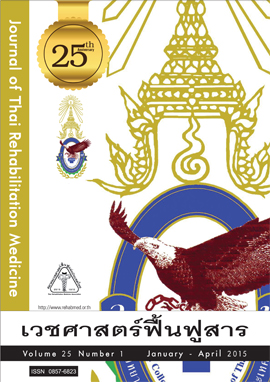ผลการลดเกร็งของแขนและมือในผู้ป่วยโรคหลอดเลือดสมอง ที่เกิดขึ้นทันที หลังจากการเหยียดยืดเอ็นและกล้ามเนื้อแบบ นิวโรฟิสิโอโลจิกเปรียบเทียบกับการเหยียดยืดแบบออร์โธปิดิคส์: รายงานการวิจัยเบื้องต้น
Keywords:
ภาวะกล้ามเนื้อหดเกร็ง, โรคหลอดเลือดสมอง, ความตึงตัวของกล้ามเนื้อ, การเหยียดยืดเอ็นและกล้ามเนื้อ, Upper limb spasticity, Post-stroke, Modified Ashworth Scale (MAS), StretchingAbstract
A Comparison of Immediate Effect of Neurophysiologic versus Orthopedic Stretching in Reducing Post-stroke Upper Limb Spasticity (ENOS-PULS): a Preliminary Study
Thueakthong W, Kumthornthip W, Khongsri N
Department of Rehabilitation Medicine, Faculty of Medicine Siriraj Hospital
Objectives: To compare the immediate effect of the neurophysiologic stretching with the orthopedic stretching in reducing post-stroke upper limb spasticity
Design: Randomized Controlled Crossover Trial
Setting: Faculty of Medicine Siriraj Hospital, Mahidol University
Subjects: 24 participants who had post- stroke upper limb spasticity with the Modified Ashworth Scale (MAS) at least 1+ out of 4.
Methods: All participants were randomized to receive both neurophysiologic and orthopedic stretching in a random sequence, and then they were evaluated immediately by a blind examiner using the MAS at pre- and post-stretching.
Results: Twenty male and four female participants were recruited in this study. Baseline characteristics included age (58.1, SD 9.6 years old), type of stroke (15 hemorrhagic, 9 ischemic), and onset after stroke (5.3, SD 4.8 years). All hemiplegics with various degrees of hand spasticity were assessed at baseline; 9 participants with MAS 1+, 10 with MAS 2, 4 with MAS 3 and 1 with MAS 4 respectively. Hand spasticity in all participants (24/24) improved from baseline by using the orthopedic stretching technique, and similarly, almost all of them (23/24) improved by using the neurophysiologic stretching. Spasticity reduction in the orthopedic stretching group was superior to that in the neurophysiologic stretching group in 7 out of 24 participants, and vice versa in only 2 out of 24. However, there was no statistically significant difference. The degree of spasticity reduction was at the same level by either type of stretching in approximately 60% of the participants (15/24).
Conclusion: The result of this preliminary study showed no statistically significant difference between the neurophysiologic stretching and orthopedic stretching. Further research trials evaluating these hypotheses are needed.
บทคัดย่อ
วัตถุประสงค์: เพื่อศึกษาผลของการตอบสนองในการลดเกร็ง อย่างทันทีโดยใช้วิธีเหยียดยืดเอ็นและกล้ามเนื้อแบบนิวโรฟิสิ-โอโลจิกเปรียบเทียบกับการเหยียดยืดแบบออร์โธปิดิคส์ในผู้ป่วย โรคหลอดเลือดสมองที่มีภาวะกล้ามเนื้อหดเกร็งของแขนและมือ
รูปแบบการวิจัย: การศึกษาแบบสุ่มเข้ากลุ่มทั้งหมดแบบไขว้กลุ่ม
สถานที่ทำการวิจัย: คณะแพทยศาสตร์ศิริราชพยาบาล มหาวิทยาลัยมหิดล
กลุ่มประชากร: ผู้ป่วยอัมพาตครึ่งซีกจากโรคหลอดเลือดสมอง จำนวน 24 คน ที่มีภาวะกล้ามเนื้อหดเกร็งของแขนและมือ โดย ใช้การประเมิน Modified Ashworth Scale (MAS) ระดับ 1+ ขึ้นไป
วิธีการศึกษา: ผู้เข้าร่วมวิจัยทุกรายได้รับการเหยียดยืดเอ็น และกล้ามเนื้อทั้งวิธีแบบนิวโรฟิสิโอโลจิกและแบบออร์โธปิดิคส์ ผู้ประเมินซึ่งไม่ทราบว่าผู้ป่วยอยู่ในกลุ่มใด ประเมินภาวะ กล้ามเนื้อหดเกร็งบริเวณมือหลังจากทำการเหยียดยืดเอ็นและ กล้ามเนื้อโดยใช้ MAS
ผลการศึกษา: ผู้เข้าร่วมวิจัยเป็นเพศชาย 20 คน หญิง 4 คน ชนิดของโรคหลอดเลือดสมอง (เลือดออกในสมอง 15 ราย สมองขาดเลือด 9 ราย) อายุเฉลี่ย 58.1(ส่วนเบี่ยงเบนมาตรฐาน 9.6) ปี ระยะเวลาที่เริ่มเป็นเฉลี่ย 5.3 (ส่วนเบี่ยงเบนมาตรฐาน 4.8) ปี ระดับความรุนแรงของภาวะกล้ามเนื้อหดเกร็งของแขน และมือ MAS 1+ จำนวน 9 ราย MAS 2 จำนวน 10 ราย MAS 3 จำนวน 4 ราย MAS 4 จำนวน 1 ราย การเหยียดยืดเอ็นและ กล้ามเนื้อทั้งสองวิธีสามารถลดภาวะกล้ามเนื้อหดเกร็งได้เมื่อ เทียบกับก่อนเหยียดยืด พบว่าแบบออร์โธปิดิคส์ลดภาวะ กล้ามเนื้อหดเกร็งได้ 24/24 รายแต่แบบนิวโรฟิสิโอโลจิกได้ 23/24 รายและเปรียบเทียบระดับความเกร็งที่ลดลงระหว่าง แบบนิวโรฟิสิโอโลจิกกับออร์โธปิดิคส์พบว่าแบบออร์โธปิดิคส์มี แนวโน้มลดลงได้มากกว่าแบบนิวโรฟิสิโอโลจิก (7/24 vs. 2/24) และลดภาวะกล้ามเนื้อหดเกร็งได้เท่ากัน 15/24 ราย
สรุป: การเหยียดยืดเอ็นและกล้ามเนื้อแบบนิวโรฟิสิโอโลจิก และแบบออร์โธปิดิคส์ยังไม่พบความแตกต่างอย่างมีนัยสำคัญ ทางสถิติ






